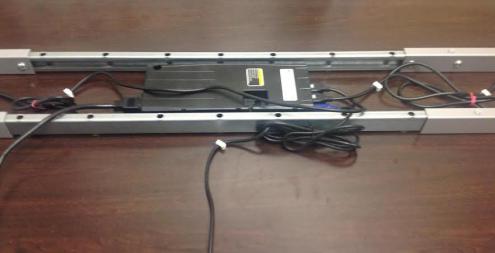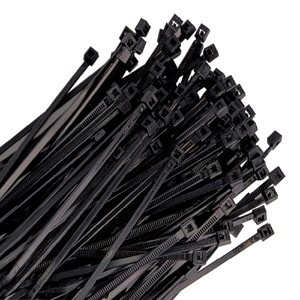DIY Cable Management for Standing Desks
Like most reviews sites, our editorial staff and laboratory testing expenses are partially offset by earning small commissions (at no cost to you) when you purchase something through those links. Learn More

Relax, a swarm of snakes has not spontaneously decided to attack your desk. Nor has a forest of exceptionally flexible bamboo sprung up around its legs – no, fellow deskers, what you’re seeing is a workstation in dire need of some cable management.
Keeping your spaghetti straight is important no matter how you’re working. Carefully organizing cables helps prevent injuries from bending behind or under your desk to plug in electronic devices, and keeps your workstation neat and efficiently arranged. It also protects your expensive gear from unwittingly demonstrating the force of gravity should someone’s foot get snagged on a cable. Besides, it just looks nice – well-kept cables are pretty enough to have inspired a borderline-fetishist Reddit group of cable control enthusiasts (welcome to the internet).
And that’s only for a stationary desk. Throw an adjustable-height desk into the mix, and you suddenly have a moving thicket of tripping hazards because of the excess slack required for cables to move along with the work surface as you rise to work standing. Not good, but then if you decide to put an office treadmill under it, too? You suddenly have a moving thicket of tripping hazards with someone walking right next to it. Really not good.
Cable management is important both in terms of aesthetics and self-preservation, for both standing desks and standing desk converters. Luckily, we’ve had plenty of time to sort out what works best for cleaning up a walking or standing workstation.
Off the Shelf Solutions
The easiest way to tackle cable management is to buy one of the several curated cable management kits we’ve reviewed. Or if you don’t need the whole kit, we’ve also reviewed individual cable trays, cable sleeves and cable chains.
But if you’d rather find a DIY solution (maybe you can’t afford to buy any cable management components or maybe you just really want to tackle this project on your own), read on. And while you’re at it, check out some of our favorite ways to improve your office ergonomics.
Bundle Those Cables
Simplicity is often the best policy. Out of sight, out of mind is rarely a solid problem-solving strategy, but it’s often the first step while taking care of cables. Getting the snarl smoothed out, coiled, and secured to the underside of your tabletop can make for a much neater workstation. Yes, the underside. Cable-proofing an adjustable workstation isn’t quite like cable-proofing a static one. In addition to bundling cables up and arranging them neatly, you need to ensure that when your desk moves, your cables move with it. The alternative is a vicious tug of war between your devices and your outlets as your desk grinds its way upwards.
How do you bundle your cables? Plastic zip ties are often the first port of call—they were literally invented for cable control, and are often the easiest way to secure your cords. Coil cables as neatly as possible, and then cinch them up with a zip tie. If your table has some handy perforations in the frame these can be used as attachment points for bundles of cabling. Pull, enjoy that satisfying zip tie rip, repeat.

If you don’t want to use zip ties, another versatile item for DIY cable management is the simple binder clip. As related to cable management, they can bundle your cables effectively, and come in handy for a couple of other methods we’ll discuss below.
And then there are even simpler and cheaper options. Have you ever wondered what to do with an empty toilet paper roll? Why not try a little recycled DIY cable management? Wind your cord up and shove it inside the roll to keep it contained. It won’t be the prettiest solution, but it does have one big upside: You can write the cord’s use on the roll. No more searching among a jumbled mess for that one specific cable to charge your old video camera.
Get Them Off the Ground
So now your cables are bundled, but the next big step is getting them off the ground. With a standing desk (and no cable tray) that pretty much means attaching the cables to the underside of your desk. Before we get into this next section, please be careful. It is painfully easy to install a screw through your desktop and ruin it. It is very important to measure your desktop thickness and pick screws of an appropriate length, ideally 1/4″ less than the desktop thickness. To make absolutely sure you don’t destroy your desktop consider investing a few dollars in a drill bit with a depth-setting collar.
Coaxial staples are a great first step if you don’t have many cables and don’t mind putting a lot of small holes under your desk. Flip your desk over, and hammer these nifty devices down. They’ll hold cables tight to the underside of your tabletop—exactly where you want them.

Another option is something we mentioned above: Binder clips. Find screws with larger heads than the narrow part wire handle part of the binder cable so they will hold the binder clip securely to your desktop. Depending on the size of the binder clip, these will hold many cables but they won’t hold quite as securely.
Keep Everything Close
 There are very few things uglier than a slew of cables dribbling off a standing desk and running to a floor-level outlet. Instead, it’s best to find some way to keep your plugs at desk level. The simplest approach? Find yourself a power strip. Make sure it has a couple of spots you can run wood screws through. Also, be sure to get a cord length of at least 12′ to give yourself enough flexibility when setting things up and at least 1000-joule surge protection to protect your electronics. Before cable management kits became a thing we often used this simple hack of screwing a power strip directly to the underside of our desks (much easier if your power strip has mounting holes protruding from its ends as opposed to being punched out of the bottom of the strip). If you’re going this route, be sure to heed our warning above about drilling into your desktop.
There are very few things uglier than a slew of cables dribbling off a standing desk and running to a floor-level outlet. Instead, it’s best to find some way to keep your plugs at desk level. The simplest approach? Find yourself a power strip. Make sure it has a couple of spots you can run wood screws through. Also, be sure to get a cord length of at least 12′ to give yourself enough flexibility when setting things up and at least 1000-joule surge protection to protect your electronics. Before cable management kits became a thing we often used this simple hack of screwing a power strip directly to the underside of our desks (much easier if your power strip has mounting holes protruding from its ends as opposed to being punched out of the bottom of the strip). If you’re going this route, be sure to heed our warning above about drilling into your desktop.

Behold, another binder clip appearance. They can clip onto the edge of your desk to keep your often-used cables close. This is one of our favorite DIY methods of the bunch because it’s essentially as effective as the purpose-built cable management clips you can buy off the shelf or with other cable management kits.

Another common issue with standing desks is the lack of a home for headphones. Fear not, DIY can help you there too. While several manufacturers sell special headphone and accessory hooks that mount under your desk, any hook that’s the right size for your headphones will work. Or if you want a fancier look, you can consider any toilet paper holder with one open end (yes we realize this is the second TP-related hack, sorry DIY cable management can get weird).
Is It Worth It?
This is the big question when it comes to DIY projects. Bundled cable management kits are often a better deal at the end of the day, both because they’re usually cheaper than buying individual components, and because their components have been curated by people who know a lot about the kinds of challenges many customers often run into, the usually have everything you’re going to need. So, fewer trips to the store or waiting for deliveries before you can finish off the job.
At the end of the day whether you buy an off-the-shelf kit or piecemeal it together, all cable management projects are in fact DIY. It’s only a question of how much you fell your time is worth.
And of course, it doesn’t stop with the ideas we mentioned. Cable management is limited only by creativity. So go forth, Cord-Wrangler, and get that desk in order.


0 Comments
Leave a response >